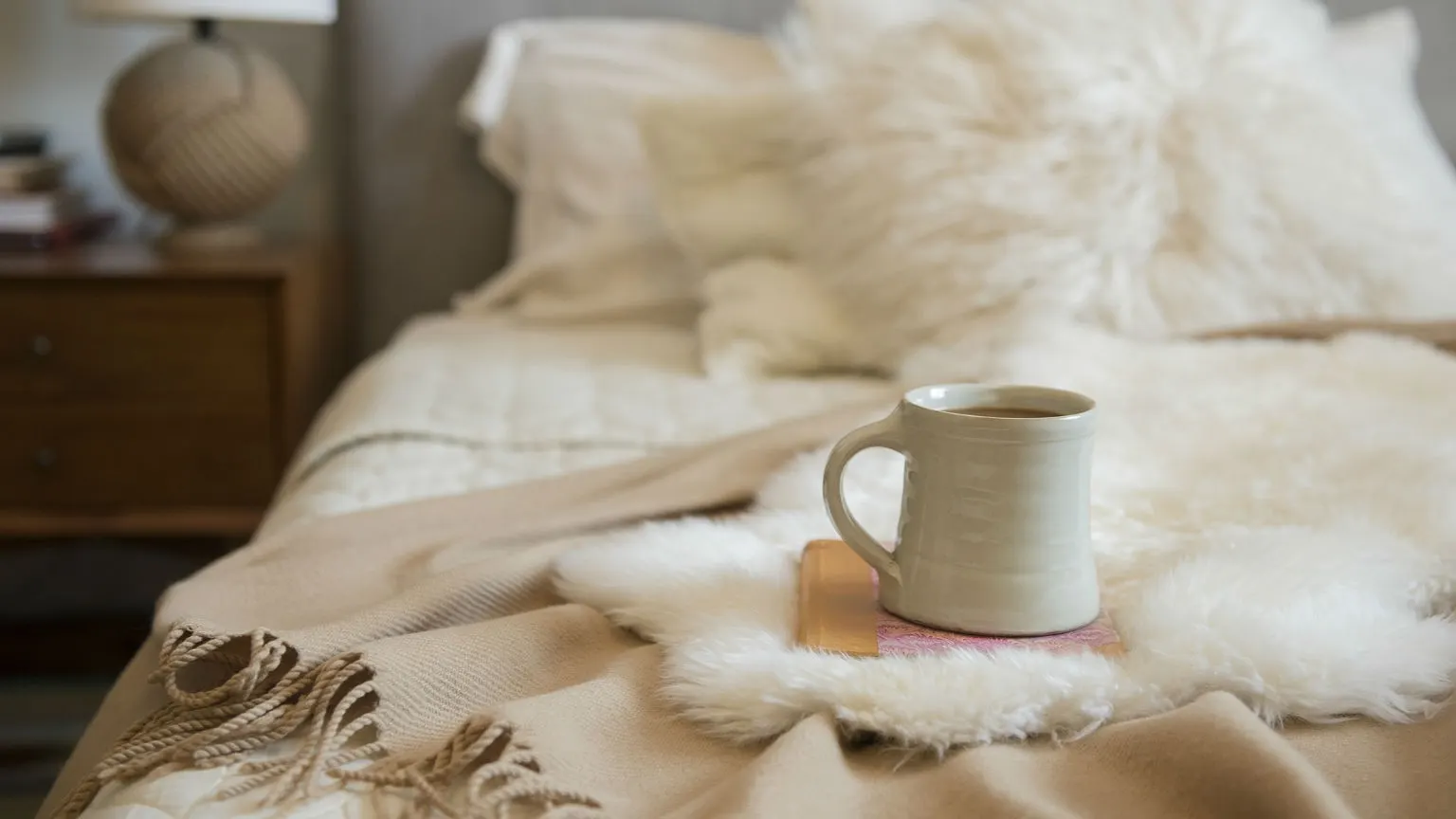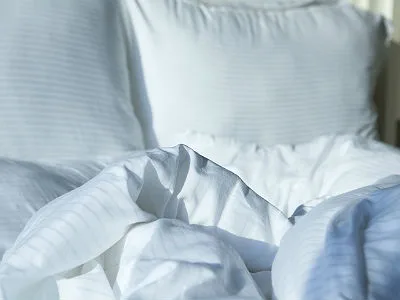Peace Lily Organic Cotton Bed Sheet Set
- Made from Egyptian GOTS certified organic cotton
- 600 thread count
- Sateen weave finish

Especially with fabrics and fibres. While cotton is still a favourite, linen has never been more popular. Silk is a growing option and likewise, many are choosing to go for bamboo.
But what's the difference? And why should you choose one over the other? Keep reading to see the differences between these fabrics and why you might want to choose one over the rest.
Cotton is a plant. The fluffy, white balls we're used to seeing in cotton wool packs at the supermarket is very much what cotton looks like when it grows. It almost looks like a furry white flower that can be picked. The fibres can then be treated and weaved into fabrics. The cotton used in most products comes from commercially farmed crops.

Cotton is a natural and breathable fabric. It's soft, easy to wash and affordable. But it can be prone to creases and look untidy over time. Cotton is often also criticised for being a crop that requires a lot of water to farm. In areas like Australia and the USA, which often experience long periods of drought, thirsty crops can overburden limited water supplies and some argue it isn't an environmentally friendly option. According to WWF it takes 20,000 litres of water to produce enough cotton to make one T-shirt and a pair of jeans.
Historically, sheets have been made from cotton. Cotton is considered a premium fabric, owing to it being a natural fibre which is more comfortable, durable and breathable than synthetics, hence more expensive. And it's the comfort factor that has made cotton the go-to choice for bed sheets. While there are fibres that are more durable and breathable than cotton, cotton is generally the softest and most comfortable natural fibre, making it ideal for bedding.
Cotton and Egyptian cotton come from different plants. The fibres from Egyptian cotton plants are longer and silkier and yield a more luxurious fabric as a result. Not all cotton grown in Egypt is technically Egyptian cotton, because the term "Egyptian cotton" refers to the specific plant type. Be careful when shopping for these sheets. Not everything labelled "Egyptian cotton" will in fact be from the Egyptian cotton plant.
Image source: Getty
Edit top picks 30-day return policy
30-day return policy  Offers Afterpay
Offers Afterpay Offers Humm
Offers Humm Accepts PayPal
Accepts PayPalLinen is another natural fibre derived from the flax plant, the same plant we get flaxseeds or linseeds from. Turning flax into linen is time-consuming, making linen an expensive fabric to buy. Linen is favoured by many for its breathability. It's a fabric that keeps you much cooler in warm weather and much warmer in cool weather when compared with other fibres. It often has a rough texture and can be slightly sheer with a crinkled-crushed appearance.

There are many reasons why linen makes for great sheets. If you find yourself too hot when sleeping, linen can offer a solution. It keeps you fresh and cool in hot weather and draws moisture away from your skin, which allows you to sleep more comfortably. It's also incredibly durable, becoming softer and more luxurious with each use and wash.
Since linen is considered an expensive and premium fabric, some will opt for linen sheets as a status symbol. For many, the crinkly appearance of linen is quite attractive. It looks better when crushed, making it easier to care for than other fabrics.
While cotton is a breathable fabric, linen definitely wins out here. Cotton breathes but can also trap heat while linen keeps you fresh and cool. Linen requires less water to farm making it a more environmentally friendly choice too. And, when it comes to washing and drying, linen is very low maintenance as it dries quickly and requires no ironing. Cotton takes a little longer to dry and will need to be ironed if crushed. Creased cotton sheets aren't a great look.
But cotton wins out in the price wars. Since linen is a laborious fabric to make, it's pricey. Although innovative brands like Bed Threads have brought the cost of linen bedding down from around $1,000 to roughly $300, cotton is still a cheaper option. Cotton is also generally softer. While linen gets soft and buttery over time (and lasts longer than other fabrics), cotton is soft from the beginning.
Image source: Pinterest
Edit top picks 30-day return policy
30-day return policy  Offers Afterpay
Offers Afterpay Offers Humm
Offers Humm Accepts PayPal
Accepts PayPalSilk is another natural fibre that comes from the spun threads of silkworms. Silk is an extremely premium fabric owing to how difficult it is to source and produce. While it's not particularly durable, it's hard to wash and is prone to stains, even from water. However, its ultra-soft, light-as-a-feather texture and glossy sheen make it still a highly sought-after fabric.

Silk sheets are something that is growing in popularity, although they have been around for years. This fabric has not always been the first choice for bedding, owing to how easily it can stain and its poor resistance to water. Many silks are not designed to be washed (although some types are designed to be washed) and the texture can change when the fabric comes into contact with liquid. It's also very thin and can tear easily, even after minimal use.
But many people will still choose silk because of how soft and light the fabric is. It's very comfortable and pleasant to lie on and is kinder on sensitive skin, eczema-prone skin and dry skin. It's also a fabric that is naturally more hypo-allergenic than others since it's less prone to dust mites. Rather than choosing entire silk bedding sets, it's become very popular to choose silk pillowcases and mix this into existing bedding. The slipperiness of silk puts less tension on your hair and skin while you sleep when compared with other fabrics. This is a kinder experience for your complexion and can help with conditions like hair loss, premature ageing and acne.
Cotton is soft but silk is softer. For absolute comfort, silk is almost unbeatable. Especially for pillowcases. But silk can't compare to cotton when it comes to price, durability and ease of care. Cotton is affordable and silk is very expensive, even more expensive than linen. Silk stains easily and is difficult to clean. And if it comes into contact with water, it can lose its soft texture.
Silk is also a fabric that comes from an animal, meaning that there are ethical concerns surrounding the sourcing and production process. It's not a vegan-friendly fabric.
Image source: Getty
Edit top picks Free shipping over $25
Free shipping over $25 30-day return policy
30-day return policy  Offers Afterpay
Offers Afterpay Offers Klarna
Offers Klarna Accepts PayPal
Accepts PayPal Free shipping over $50
Free shipping over $50 60-day return policy
60-day return policy  Offers Afterpay
Offers Afterpay Accepts PayPal
Accepts PayPalBamboo is a plant originating from Asia. It's technically a grass and is known for being one of the fastest growing plants in the world. Highly versatile, bamboo is used in cooking, building, construction and textiles. It's very strong with better compressive strength than concrete and a tensile strength that is higher than steel (when calculated by weight).
Before you can make sheets out of bamboo, it needs to be processed into a textile. Bamboo is typically made into rayon, viscose or lyocell, which are man-made natural fibres - meaning the origin is natural but it has been processed, unlike cotton. So don't be confused if you see bamboo rayon. Rayon just relates to the way the bamboo has been processed.

Bamboo sheets are growing in popularity because bamboo is a more sustainable option. Some argue that bamboo is even softer than cotton and linen (but not as soft as silk), is less susceptible to bacteria and is more absorbent. It's also breathable, keeping you cool in summer and warm in winter. As a result, many people will choose bamboo sheets for health and ethical reasons.
Recently, bamboo sheets have been viewed as a vegan alternative to silk bedding. Some companies like Ettitude make bamboo lyocell sheets and turning bamboo into lyocell yields a much softer, silkier result than rayon. Bamboo lyocell sheets have the same feather-light silky feel as silk but without any animal involvement.
Bamboo has been hailed as one of the most sustainable and best options for bedding. Not only does bamboo need less water to grow when compared to cotton, it also uses less water during production than other fabrics. This is because the water used in production can be recycled. It's also naturally antimicrobial, meaning is stops bacteria growing, and hypo-allergenic.
It's similar to cotton in terms of breathability, since both are natural fibres. But for some cotton may still win in terms of feel and weight. Some will prefer the soft, weighted feeling of a cotton sheet. Bamboo can also be a bit more costly. While bamboo is roughly the same price as high-quality cotton, lower-quality cotton is a lot cheaper.
Image source: Pinterest
Edit top picks Offers Afterpay
Offers Afterpay Offers Klarna
Offers Klarna Accepts Apple Pay
Accepts Apple Pay Accepts PayPal
Accepts PayPal Free shipping over $100
Free shipping over $100 Offers Afterpay
Offers Afterpay Accepts PayPal
Accepts PayPalIt's totally up to you. Using myself as an example, I oscillate between cotton and linen with silk pillowcases. I like using silk pillowcases because my hair doesn't get as knotty on silk and I find I lose fewer eyelashes.
As for what I put on my mattress, in winter I have thick cotton sheets that I really like the look of. They're super warm too. In summer, I generally have linen sheets on my bed because they're cooler than my cotton ones. Much of this decision is down to the appearance, not just temperature. I think linen looks stylish and summery and I think cotton looks more wintry and cosy.
So, it's really just down to personal preference. It's very hard to say whether one is definitively better than the other.
Just because something is man-made, doesn't mean it's not natural. Take rayon as an example. Rayon is a class of fabric which includes viscose, lyocell and modal, all of which (while being processed and made by man) are crafted from materials of natural origin. Rayon is often made out of wood pulp or bamboo.
The difference between something like rayon and cotton is that cotton isn't processed. It grows, is picked and then weaved. It doesn't need to be "turned into" a weavable fibre.
Synthetic fibres are textiles or materials that have been made and processed from material, not of natural origin. The most commonly known example of this would be polyester. Polyester is a fabric that has been made from plastics.
We have rounded up the top sites where you can buy bedsheets online. Once you've made a decision on whether to buy linen, cotton, silk or bamboo sheets, here's our list of stores where you can order them online.
Edit product set| Last checked | Code description | Code |
|---|---|---|
| 12 Mar 2025 | 20% off bedding, bath, basics and more at Bhumi | BHU**** |
| 19 Aug 2024 | 5% off your orders with code | FIN**** |
| 12 Jul 2024 | Extra 5% off your orders | FIN**** |
| 2 Aug 2023 | $120 off with code | FIN**** |
| 18 Mar 2025 | Up to 30% off Ergoflex 5G Memory Foam Mattress | APD**** |
All the essential information you need to know to choose a high-quality water filter for your home.
These are the nine best sofa beds you can buy right now in Australia.
These are the 8 best shower heads you can get right now in Australia.
These are the 9 best desk lamps you can buy right now in Australia.
These are the 9 best diffusers you can get online.
These are the 7 best pens you can buy right now in Australia.
We’ve found the best gaming chairs available online for every budget and need.
These are the 7 best gas cooktops you can get right now in Australia.
These are the best ceramic cooktops you can buy right now in Australia.
These are the 10 best induction cooktops you can get right now in Australia